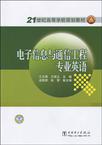电子信息与通信工程专业英语
2009-5
中国电力出版社
王立琦,王铭义 主编
282
301000
电子信息与通信技术是目前发展最为迅速也是最为活跃的研究领域之一。随着我国国力的增强,对外交流日益广泛,迫切需求既懂得专业知识又具备专业英语综合运用能力的科研人员,因此对在校大学生英语水平的要求也越来越高。根据国家教委《大学英语教学大纲(修订版)》的规定,要通过四年不断线的学习提高学生的英语语言应用能力,因此专业英语是继大学公共英语之后理工科大学生的一门必修课程。 编者希望结合自己多年专业英语及其他专业课程教学实践中的经验体会,在力求通俗、简明、扼要和实用的指导思想下编写一本电子信息与通信工程专业英语教材,以期在有限的学时内培养学生专业英语阅读、翻译和写作的综合运用能力,全面提高英语素质。 全书由基础篇和提高篇两部分组成,授课教师可以根据需要及课时安排选讲或分学期讲授其中的内容。 本书的阅读材料均选自国外原版教材或技术网站,经适当编写而成,这样可以保证语言地道、用词规范。内容选取紧密结合电子信息与通信专业开设的课程,按专业知识体系结构编排,由浅入深,贯穿电子信息和通信工程专业的主要专业课程,包括电子学、信号与系统、数字信号处理、通信技术、计算机网络、移动电话、光纤通信、信息理论与编码、数字图像处理和嵌入式系统。考虑到大三的学生虽然已经具备了一定的英语语言基础,但是毕竟刚刚进入专业课程的学习,在具体内容的遴选上技术层面不要太深,否则学生读不懂,会失去学习兴趣,也给授课教师造成很大困难。课文的内容既对专业基础课和专业课进行必要的重复,尽量保证学生利用既有专业知识理解课文的内容,又有所拓宽和延伸,增强学生阅读兴趣,扩充专业词汇量,扩展和深化对本学科关键技术的认识。每篇课文后配有生词表和难旬注释,旨在解决课文中的英语语言难点和专业知识难点,在一定程度上减轻学习负担。 在具备了一定阅读量的基础上,必须加以总结提炼,否则读得再多也只是内容的堆砌,而不是能力的提高。本书翻译部分独立成章,系统地介绍科技英语翻译的一般方法和技巧,通过学习学生可熟悉和掌握相关领域科技英语句法结构特点和常用表达方式,提高阅读和翻译专业英语资料的能力。 由于本科生在撰写毕业论文时必须给出英文标题和英文摘要,而学生这方面的能力相对薄弱,因此编者认为英文标题和摘要的写作应该纳入本科专业英语授课计划。所以本书将这一部分也独立成章,通过大量实例,详细讲解科技论文标题和摘要的写作要求及常用句型结构、表达方式,力求学以致用。 本教材的最主要特色是紧密结合专业课程,充分考虑学生的实际情况和教师授课盼可操作性,阅读材料选材新颖,内容丰富,注重专业基础和关键技术,兼顾发展热点;翻译和写作部分系统性强,实用性强。
本书是21世纪高等学校规划教材。 全书分基础篇和提高篇两部分,共12章。基础篇包括电子学、信号与系统、数字信号处理、通信技术、计算机网络、英文专业文献的翻译共6章;提高篇包括移动电话、光纤通信、信息论与编码、数字图像处理、嵌入式系统、英文科技论文标题和摘要的写作共6章。本书内容涵盖了电子信息和通信工程专业的主要课程,每一章构成一个相对完整的专题,重点介绍基本概念、原理、方法与应用,每章后面附有专业词汇和难点注释。 本书可作为高等院校电子信息工程与通信工程专业本科生教学用书,也可供相关专业的工程技术人员学习和参考。
前言基础篇 Chapter 1 Electronics 1.1 Electronic Devices and Types of Circuits 1.2 Operational Amplifier 1.3 Boolean Algebra and Logic Circuits 1.4 FIip-Flops Chapter 2 Signals and Systems 2.1 Signals 2.2 Systems Chapter 3 Digital Signal Processing 3.1 Z-Transfornl 3.2 Discrete Fourier Transform Chapter 4 Communication Technology 4.1 Introduction to Communication Systems 4.2 Modulmion Techniques 4.3 Multimedia Communication Technology Chapter 5 Computer Network 5.1 Introduction 5.2 Components ofa Network 5.3 Network Architecture and OSI Reference Model 5.4 TCP/IP 第6章 英文专业文献的翻译 6.1 专业英语的基本特点 6.2 专业英语翻译的标准 6.3 专业英语翻译的基本方法 6.4 专业术语的翻译 6.5 常用数学符号和公式翻译提高篇 Chapter 7 Mobile Phone 7.1 Overview 7.2 Usage 7.3 History 7.4 Terminology Chapter 8 Fiber-optic Communication 8.1 Applications 8.2 History 8.3 TechnologY 8.4 Comparison with Electrical Transmission 8.5 Governing Standards Chapter 9 Information Theory and Coding 9.1 BriefIntroduction 9.2 Entropy 9.3 Source Coding 9.4 Error Control Coding Chapter 10 Digital Image Processing 10.1 Digital Representation ofImages 10.2 Fundamental Me也ods ofImage Processing 10.3 Application ofDigital Image Processing Chapter 11 Embedded Systems 11.1 111e Main Idea 11.2 PIC Hardware 11.3 PIC Software 11.4 System Design 第12章 英文科技论文标题和摘要的写作 12.1 英文科技论文体例 12.2 英文标题的翻译 12.3 英文摘要的重要性 12.4 英文摘要的种类 12.5 英文摘要写作的基本要求 12.6 英文摘要写作常用句型结构 12.7 英文摘要范例参考文献
From the 1960s until the present,the field of image processing has grown vigorously;In addition to applications in medicine and the space program,digital image processing techniques now are used in a broad range of applications.Computer procedures are used to enhance the contrast or code the intensity levels into color for easier interpretation of X-rays and other images used in industry,medicine,and the biological sciences .Geographers use the same or similar techniques to study pollution paaems from aerial and satellite imagery.Image enhancement and restoration procedures are used to process degraded images of unrecoverable objects or experimental results too expensive to duplicate.In archeology,image processing methods have successfully restored blurred pictures that were the only available records ofrare artifacts lost or damaged after being photographed.In physics and related fields,computertechniques routinely enhance images of experiments in areas such as high-energy plasmas and electron microscopy. Similarly successful applications of image processing concepts can be found in astronomy, biology, nuclear medicine,law enforcement, defense,and industrial applications. These examples illustrate processing results intended for.human interpretation.The second major area of application of digital image processing techniques is in solving problems dealing with mach.ine perception.In this case,interest focuses on procedures for extracting from an image information in a form suitable for computer processing.Often,in machine perception are statistical moments,Fourier transform coefficients,and multidimensional distance measures.Typical problems in machine perception that routinely utilize image processing techniques are automatic character recognition,industrial machine vision for product assembly and inspection,military recognizance,automatic processing of fingerprints, screening of X-rays and blood samples,and machine processing of aerial and satellite imagery for weather prediction and environmental assessment.The continuing decline in the ratio of computer price to performance and the expansion of networking and communication bandwidth via the World Wide Web and the Internet have created unprecedented opportunities for continued growth of digital image Droocessjng.
《电子信息与通信工程专业英语》的最主要特色是紧密结合专业课程,充分考虑学生的实际情况和教师授课的可操作性,阅读材料选材新颖,内容丰富,注重专业基础和关键技术,兼顾发展热点;翻译和写作部分系统性强,实用性强。 编者希望结合自己多年专业英语及其他专业课程教学实践中的经验体会,在力求通俗、简明、扼要和实用的指导思想下编写一本电子信息与通信工程专业英语教材,以期在有限的学时内培养学生专业英语阅读、翻译和写作的综合运用能力,全面提高英语素质。全书由基础篇和提高篇两部分组成。

没有中文翻译 不好懂
很难,我读理科的都看不明白里面的公式。
本人学英语专业的,看到很是纠结!!帮弟弟买的,今年他刚上大一学电子信息工程的~~~大概看了看有难度啊,呵呵O(∩_∩)O~坚持学习相信有所收获!加油,学无止境~
实用性还可以辅以实际工作,进行更深入学习